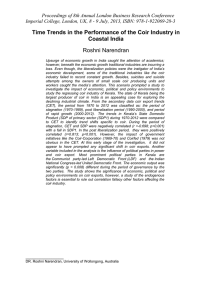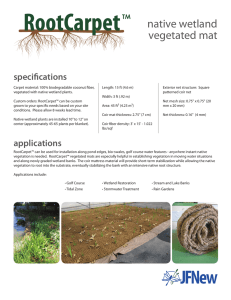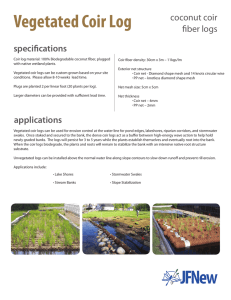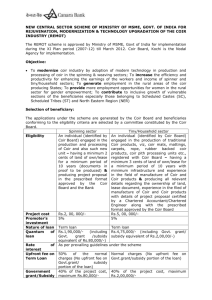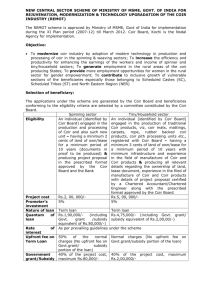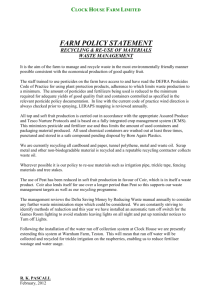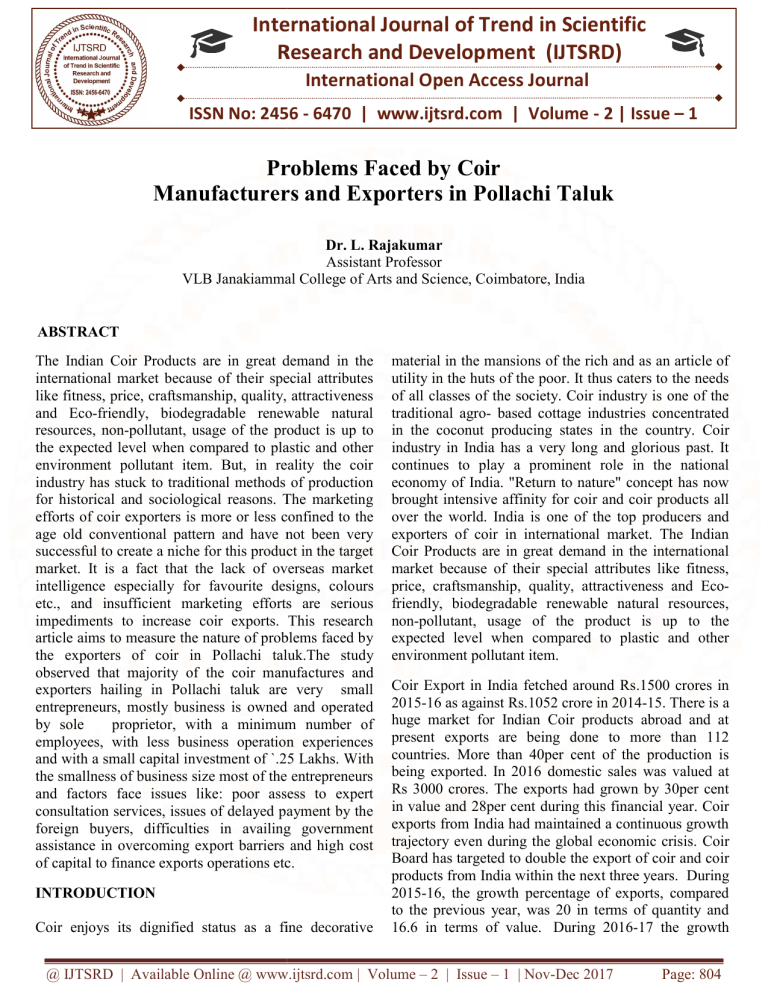
International Journal of Trend in Scientific Research and Development (IJTSRD) International Open Access Journal ISSN No: 2456 - 6470 | www.ijtsrd.com | Volume - 2 | Issue – 1 Problems Faced by Coir Manufacturers and Exporters in Pollachi Taluk Dr. L. Rajakumar Assistant Professor VLB Janakiammal College of Arts and nd Science, Coimbatore, India ABSTRACT The Indian Coir Products are in great demand in the international market because of their special attributes like fitness, price, craftsmanship, quality, attractiveness and Eco-friendly, friendly, biodegradable renewable natural resources, non-pollutant, usage of thee product is up to the expected level when compared to plastic and other environment pollutant item. But, in reality the coir industry has stuck to traditional methods of production for historical and sociological reasons. The marketing efforts of coir exporters orters is more or less confined to the age old conventional pattern and have not been very successful to create a niche for this product in the target market. It is a fact that the lack of overseas market intelligence especially for favourite designs, colo colours etc., and insufficient marketing efforts are serious impediments to increase coir exports. This research article aims to measure the nature of problems faced by the exporters of coir in Pollachi taluk.The study observed that majority of the coir manufa manufactures and exporters hailing in Pollachi taluk are very small entrepreneurs, mostly business is owned and operated by sole proprietor, with a minimum number of employees, with less business operation experiences and with a small capital investment of `.25 25 Lakhs. With the smallness of business size most of the entrepreneurs and factors face issues like: poor assess to expert consultation services, issues of delayed payment by the foreign buyers, difficulties in availing government assistance in overcoming export barriers and high cost of capital to finance exports operations etc. INTRODUCTION Coir enjoys its dignified status as a fine decorative material in the mansions of the rich and as an article of utility in the huts of the poor. It thus caters to the needs of all classes of the society. Coir industry is one of the traditional agro- based cottage industries concentrated in the coconut producing states in i the country. Coir industry in India has a very long and glorious past. It continues to play a prominent role in the national economy of India. "Return to nature" concept has now brought intensive affinity for coir and coir products all over the world. India dia is one of the top producers and exporters of coir in international market. The Indian Coir Products are in great demand in the international market because of their special attributes like fitness, price, craftsmanship, quality, attractiveness and Ecofriendly, riendly, biodegradable renewable natural resources, non-pollutant, pollutant, usage of the product is up to the expected level when compared to plastic and other environment pollutant item. Coir Export in India fetched around Rs.1500 Rs crores in 2015-16 as against Rs.1052 1052 crore in 2014-15. There is a huge market for Indian Coir products abroad and at present exports are being done to more than 112 countries. More than 40per cent of the production is being exported. In 2016 domestic sales was valued at Rs 3000 crores. The he exports had grown by 30per cent in value and 28per cent during this financial year. Coir exports from India had maintained a continuous growth trajectory even during the global economic crisis. Coir Board has targeted to double the export of coir and coir co products from India within the next three years. During 2015-16, 16, the growth percentage of exports, compared to the previous year, was 20 in terms of quantity and 16.6 in terms of value. During 2016-17 2016 the growth @ IJTSRD | Available Online @ www.ijtsrd.com | Volume – 2 | Issue – 1 | Nov-Dec Dec 2017 Page: 804 International Journal of Trend in Scientific Research and Development (IJTSRD) ISSN: 2456-6470 percentage was increased to 27.3 in terms of quantity and 20 in terms of value. There has been an increasing trend in the exports of coir and coir products year to year, it is expected that the trend will continue during the coming years also.For the Indian coir exports the US is the largest market accounting for 37per cent. The domestic market for coir products is currently estimated at Rs 2000 crore and this is expected to grow to Rs 3500 crore by 2017. The Coir Board has earmarked Rs.4.59 crore financial assistance in 2012-13 for the development of coir industry in various states. Nature of Problems Faced by Coir Industry in India The coir industry has stuck to traditional methods of production for historical and sociological reasons. The industry cannot go on far into the future, with its present method of production, mechanisation of defibring and spinning sectors would displace labour in large numbers. Inadequacy of raw material is one reason for the decrease in employment and the high cost raw material in the cost production. Primary coir is the large employer unit but mostly underemployment, part-time employment and secondary employment. With below par sustenance wages conditions of work to a large mass of unorganised casual workers. The entrepreneurial initiative in coir is essentially individualistic with a property orientation; even there are some corporate facades. The role of professionalism is somewhat restrained by the very definition of trade structure large business house of a country have chosen to keep away from coir and again, expatriate interest from consuming countries and multinational have been kept away. The organisation of overall industry is fragile. The weakest link in its economic strength is a discarded waste husk becoming the primary raw material, lack of integration with the effective farming lobby of growers of coconuts, absence of large corporate and professionalism – absence of even remote nexus with product sector. These factors are inescapable realities not readily conducive for exponential forward in growth in volume: value, product profile and quality of coir industry. The growth of coir in quantity or quality terms in its traditional setting is not optimistically promising while the economic disabilities of the commodities and the weakest of the trade and explicit coir areas, the social issues of the coir workers are compounding the complex problems. When it is take into account the market, the domestic market within the country largely by private traders. The internal consumption coir yarn in India is about 85 per cent and only 40 per cent of the indigenous production of coir door mat, mattings etc., is estimated to be consumed within the country. Because of the emergence of plastic fiber, the substitute for fiber, the demand for coir fiber declining day by day. In spite of positive growth of coir products from India a general lowering trend has been noticed in the international market in the demand for coir products vis-a-vis other competing products. The reasons for this trend could be attributed to the ever increasing shift competition synthetic floor coverings and cheaper natural substitutes like gross products backed by aggressive marketing efforts. The marketing efforts of coir exporters is more or less confined to the age old conventional pattern and have not been very successful to create a niche for this product in the target market. It is a fact that the lack of overseas market intelligence especially for favourite designs, colours etc., and insufficient marketing efforts are serious impediments to increase coir exports. The traditional coir items such as coir mats, mattings, rugs carpets etc. have not shown appreciable growth of exports. The high tariff rate for coir existing in various importing countries is one of the main hurdles for promoting coir and coir products. The tariff regime prevailing now varies between 2 to 30 per cent in various countries according to the information collected by the coir board. Apart from the tariff, very often several non-tariff barriers are impeding the growth of export market for coir products. They include allegations of child labour, restrictive banking facilities, import quota restriction, antidumping measure etc. Economic Significance of Pollachi and the Nature of Problems Faced by the Coir Manufactures and Exporters India accounts for more than two-thirds of the world production of coir and coir products. Kerala is the home of Indian coir industry, particularly white fibre, accounting for 61 percent of coconut production and over 85 per cent of coir products. The Coir industry in Kerala is totally depending on Tamil Nadu in terms of coir fibre supply. Only a very little quantity fibre is being produced in Kerala and Kerala is procuring approximate 90per cent of coir fibre from Tamil Nadu of total consumption in the state. Pollachi, located 40km from Coimbatore, has 6.30cr coconut trees, cultivated across 30,000 acres, which yield 10 million coconuts daily. Each coir manufacturing factory requires about 50,000 coconut husks daily. Pollachi saw a boom in the coir industry. The number of @ IJTSRD | Available Online @ www.ijtsrd.com | Volume – 2 | Issue – 1 | Nov-Dec 2017 Page: 805 International Journal of Trend in Scientific Research and Development (IJTSRD) ISSN: 2456-6470 2456 factories doubled, increasing the cost of raw material. Since 2014, the Coimbatore district has been witnessing drought, which has resulted in reduction of coconut production in Pollachi area, this situation in turn resulted in increasing easing the raw material cost i.e., the cost of coconut husk. With the industry slowing down, thousands who were rendered jobless have either migrated to Tirupur garment factories or work as labourers in various developing resorts in Pollachi.Moreover, the coir fiber industry in Pollachi has seen a 50 per cent decline in domestic supply and a 30 per cent reduction in exports leaving thousands of people jobless. As per data available with various coir manufacturing associations in the district, the number of units has reduced by 40 per cent over the last one year, due to various reasons including a spike in manufacturing costs and the availability of cheaper fiber from Indonesia and Philippines. Statement of Problem The Development of Coir Industry has taken place in areas where there is concentration of coconut cultivation and availability of coconut husks. It is an undeniable fact that the steady increase in the export indicates a fast expanding export market for coir. The marketing efforts of coir manufactures ures and exporters are more or less confined to the age old conventional pattern and have not been very successful to create a niche for this product in the target market. It is a fact that the lack of overseas market intelligence especially for favourite designs, colours etc., and insufficient marketing efforts are serious impediments to increase coir exports. Similarly, it has been understood from the elaborate literature reviews that though India has evolved several modern methods both in terms of productt and marketing there are several potentials which manufactures have not been able to tap. Since the manufacturers and exporters faces certain issues pertaining to their geographical area, which differs from other regions where coir products are produced and exported. Aims of the Study To assess the business profile of the exporters of coir in Pollachi taluk. To measure the nature of problems faced by the exporters of coir in Pollachi taluk. Research Methodology This study is focused on the coir firms operating in Pollachi taluk of Coimbatore district.Current district. empirical study is both explorative and descriptive in nature. Questionnaire was used to collect the primary data from the selected respondents for the analysis. analysis Three hundred coir manufacturing and d exporting firms operating around Pollachi was chosen as the sample population. Coir industry is a major contributor to the economy of Pollachi, this industry give huge opportunities to employment of local residents and outsourcing of small works to various us other industries. Data Analysis and Findings Out of 300 respondents’ surveyed 71.33 per cent of coir firms were owned as sole proprietorship, proprietorship 15.33 per cent of respondents’ form a part of o coir manufacturing companies and rests of 13.33 per cent of respondents’ re are running firms i.e., a commercial partnership of two or more persons, especially when unincorporated. EXHIBIT: 1 OWNERSHIP PATTERN OF THE COIR FIRMS @ IJTSRD | Available Online @ www.ijtsrd.com | Volume – 2 | Issue – 1 | Nov-Dec Dec 2017 Page: 806 International Journal of Trend in Scientific Research and Development (IJTSRD) ISSN: 2456-6470 2456 Itt has been 46.33 per cent of respondents’ are running the firm for the past 5 years or less than that. Similarly 39.67 per cent of sample populations’ are engaged in coir manufacturing business for the past 10 years or more than that and 14 per cent of coir manufacturers’ have said that they are running the firm for the past 5510 years. EXHIBIT: EXHIBIT 4 MONTHLY NTHLY TURNOVER EXHIBIT: 2 AGE OF CONCERN Itt has been inferred that, 46.33 per cent of the coir manufacturers’ have invested around `.50 .50 Lakhs as the capital to start the business. Batch of 39.67 per cent of respondents’ have invested a capital of `.25 .25 Lakhs and 14 per cent of sample populations’ have invested a capital of in their business. The study findings reveal that 61.33 per cent of coir manufacturers’ have hired only 10 employees in their organization. Followed by, 29.33 per cent of respondents’ organization constitutes of 10-20 10 members. On the other hand, 9.34 per cent ce of manufacturers’ have opined that their organization consists of more than 20 workers. EXHIBIT: EXHIBIT 5 EMPLOYEE STRENGTH Mean Score EXHIBIT: 3 CAPITAL INVESTMENTS 60 40 20 0 46.33 39.67 14 Upto Rs.25 Rs.25 to Above Rs.50 Lakhs Rs.50 Lakhs Lakhs Capital Investments Out of 300 respondents’ surveyed, 57.33 per cent of the firms yield turnover of `.5 to `.15 .15 lakhs per month. Similarly 39.34 34 per cent of the coir manufacturers’ make a turnover of `.5 .5 lakhs and 2.33 per cent make a turnover of`.15 to `.25 .25 lakhs per month. And the rests of 1 per cent of sample populations’ yield turnover of `.35 lakhs or more than that per month. Among 300 coir manufacturers’ surveyed, almost i.e., 97.40per per cent of coir manufacturers’ produce only one product (48.70 per cent) orr otherwise 1 to 5 products (48.70 per cent) in their firms. Subsequently it has been observed that 2.60 per cent of coir manufacturing in PollachiTaluk produces more than 5 types of products using coir products. @ IJTSRD | Available Online @ www.ijtsrd.com | Volume – 2 | Issue – 1 | Nov-Dec Dec 2017 Page: 807 International Journal of Trend in Scientific Research and Development (IJTSRD) ISSN: 2456-6470 2456 EXHIBIT: 6 VARIETY OF PRODUCTS MANUFACTURE It is evident from the above table that, majority i.e., 93.67 per cent of coir manufactures’ always target on the International market to trade their products. On the contrary, 6.33 per cent of manufacturers’ are selling their products in the domestic market. EXHIBIT: 7 TARGETED MARKET This sub section of the study analyses about the coir manufacturers’ level of perception on nature of problems encountered. @ IJTSRD | Available Online @ www.ijtsrd.com | Volume – 2 | Issue – 1 | Nov-Dec Dec 2017 Page: 808 International Journal of Trend in Scientific Research and Development (IJTSRD) ISSN: 2456-6470 TABLE: 1 PROBLEMS FACED BY COIR INDUSTRY IN EXPORTING GOODS Problems Sum Mean Rank 1241 4.14 6 Lack of Export Marketing Research 1177 3.92 16 Lack of Competitive Price 1362 4.54 1 Lack of Experts in Export Consulting 1268 4.23 2 Payment Delays From Overseas Buyers and Distributors 1212 4.04 13 Ineffective National Export Promotion Program 1234 4.11 9 Foreign Government Rules and Regulation 1216 4.05 12 Exchange Rate Fluctuation 1256 4.19 3 Lack of Government Assistance in Overcoming Export Barriers 1244 4.15 5 Poor Product Design and Style for Export Markets 1250 4.17 4 High Cost of Capital to Finance Exports 1223 4.08 10 Un-availability of Technology 1240 4.13 7 Lack of Financing Assistance 1225 4.08 10 Uncertain Orders/No Regular Orders 1237 4.12 8 Power Fluctuation 1210 4.03 14 Increasing in Labour Cost 1183 3.94 15 Non-Availability of Regular Supply of Raw Materials 1168 3.89 17 Lack of Expert in Export Consultancy Source: Primary Data Conclusion Majority of the coir manufactures and exporter of coir product functioning in Pollachi claim that they lack The study observed that majority of the coir experts support for right and valuable consultation, manufactures and exporters hailing in Pollachi taluk are which they consider as the major drawback for their very small entrepreneurs, mostly business is owned proprietor, with a minimum promotion and development, this variable is ranked in and operated by sole first place with the mean score of 4.54. Subsequently it number of employees, with less business operation has been inferred that the sample subjects’ are affected experiences and with a small capital investment of `.25 by the payment delays from overseas buyers and Lakhs. With the smallness of business size most of the distributors, lack of government assistance in entrepreneurs and factors face issues like: poor assess overcoming export barriers and high cost of capital to to expert consultation services, issues of delayed finance exports. These variables are ranked in second, payment by the foreign buyers, difficulties in availing third and fourth position with an average score of 4.23, government assistance in overcoming export barriers 4.19 and 4.17, respectively. Similarly the and high cost of capital to finance exports operations manufacturers’ in Coir industry have opined that they etc. face various problems like poor product design & style The Government Agencies like policy makers, Coir for export markets, lack of export marketing research, Board of India and other voluntary organisation have to lack of financing assistance, power fluctuation, foreign realise the fact that the golden fiber coir has higher government rules and regulation, uncertain orders/no market demand in various world countries. As coir regular orders and un-availability of technology in products are considered as substitution for the running the business. Followed by, the respondents’ protecting mother earth from various natural hazards have said that they are affected by the barriers like and coir product can be easily substituted many of exchange rate fluctuation, ineffective national export modern day product like: floor mats, doors, separators, promotion program, increasing in labour cost, noncar and household decorative products, coir can be used availability of regular supply of raw materials, lack of in prevention of soil erosion, used as mud for competitive price and lack of expert in export cultivation of crops, flowers and plants etc. The consultancy in the Coir manufacturing industry. Government Agencies like policy makers, Coir Board of India and other voluntary organisation have to provide required assistance and support to the small manufacturers and exporters of coir product both to @ IJTSRD | Available Online @ www.ijtsrd.com | Volume – 2 | Issue – 1 | Nov-Dec 2017 Page: 809 International Journal of Trend in Scientific Research and Development (IJTSRD) ISSN: 2456-6470 earn more foreign exchanges, to retain Indian competitive position in coir exports and also for the retaining of the entrepreneurs in the business in long run. References 1) Jose .V. S (2002), A Study of Coir Vyavasaya CoOperative Societies in Kerala performance, Problems and Prospects,Ph.D thesis submitted to the Cochin university of science and technology for the award of the degree of Doctor of philosophy in commerce (Faculty of Social Sciences), Department of Applied Economics, Cochin University of Science and Technology, Cochin. 2) Nagaraja.G (2011)Export of coir and coir products from India: An analysis, International Journal of Research in Commerce, it & Management, Volume.No.1, issue.No.6, PP:109-111, October. ISSN 2231-4245, 3) The fiber of Pollachi's coir industry imperilled, The Times of India,8th June, 2015. 4) Executive Summary: Status of Coir Industries in India (2016), Coir Board, Cochin, oirboard.gov.in/wpcontent/uploads/2016/09/Executive-SummarySurvey-of-Coir-Industries-in-India.pdf 5) Indian Coir Industry at a Glance in 2015-16, http://www.indianmirror.com/indianindustries/2016/coir-2016.html 6) ShriGiriraj Singh (2017), Minister of State for MSME,RajyaSabha on 26.07.2017, http://pib.nic.in/newsite/PrintRelease.aspx?relid=16 9026 @ IJTSRD | Available Online @ www.ijtsrd.com | Volume – 2 | Issue – 1 | Nov-Dec 2017 Page: 810
